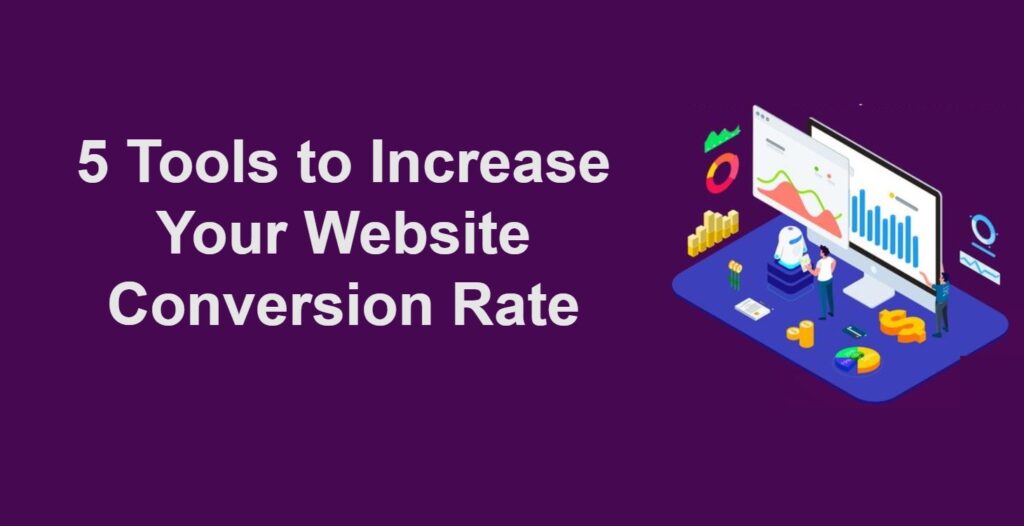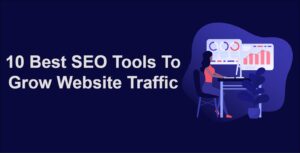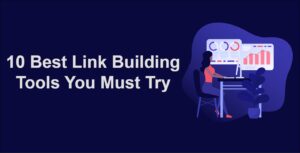In today’s digital landscape, having a visually appealing and user-friendly website is just the beginning. To succeed online, businesses need to focus on maximizing their website’s conversion rate – the percentage of visitors who take the desired action, whether it’s making a purchase, signing up for a newsletter, or filling out a contact form.
Fortunately, there are powerful tools available that can help you optimize your website and boost your conversion rates. In this article, we’ll explore five essential tools that can play a pivotal role in increasing your website’s conversion rate.
A high website conversion rate is essential for achieving business success in the competitive online landscape. Utilizing these tools can significantly enhance your ability to optimize your website, improve user experience, and boost conversion rates.
By gaining valuable insights into user behavior, visualizing user interactions, capturing leads with effective popups, creating high-converting landing pages, and gathering user feedback, you’ll be well-equipped to make data-driven decisions that lead to increased conversions and a thriving online presence. Remember that continuous testing, analysis, and refinement are key to achieving and maintaining optimal conversion rates.
What is a website conversion rate
Website conversion rate is the percentage of visitors who take a desired action on your website, such as making a purchase, signing up for a newsletter, filling out a contact form, or any other activity that aligns with your business goals. It’s a key metric measuring how effectively your website converts visitors into customers or leads.
How To Calculate A Website Conversion Rate
The formula to calculate the website conversion rate is as follows:
Conversion Rate = (Number of Conversions / Total Number of Visitors) * 100
For example, if your website receives 1,000 visitors in a month and 50 of them make a purchase, your conversion rate would be 5%:
(50 / 1,000) * 100 = 5%
A higher conversion rate indicates that a larger proportion of your visitors are taking the desired actions, which is a positive sign of the effectiveness of your website’s design, content, and user experience.
Monitoring and optimizing your conversion rate can help you improve your website’s performance and achieve your business objectives.
Why is website conversion rate so Important?
The website conversion rate is a crucial metric that holds significant importance for online businesses.
Conversion rate indicates how successful your website is at turning visitors into desired actions, such as purchases, sign-ups, or inquiries. It directly reflects your website’s ability to achieve its intended goals.
A higher conversion rate means more visitors are taking the desired actions, leading to increased sales, leads, or engagements. This directly contributes to business growth and revenue generation.
Monitoring conversion rates helps pinpoint areas of improvement in your website’s design, user experience, and content. You can optimize conversion bottlenecks to enhance the user journey by identifying conversion bottlenecks.
Conversion rates provide a tangible way to measure the return on investment (ROI) for your marketing campaigns and website enhancements. You can assess which strategies are driving the most valuable actions.
Low conversion rates indicate usability issues or barriers that discourage visitors from taking action. Improving these aspects can enhance user experience and boost conversions.
Informed Decision-Making: Conversion rate data guides strategic decisions. It helps determine where to allocate resources for website improvements, content creation, and marketing strategies.
A higher conversion rate sets you apart by demonstrating a more effective and user-friendly online presence.
Content Effectiveness: By analyzing which content leads to conversions, you gain insights into what resonates with your audience and can tailor your content strategy accordingly.
Understanding conversion patterns among different audience segments lets you personalize experiences and target specific groups more effectively.
How To Improve Conversion rate on a website
Improving the conversion rate on a website involves optimizing various elements to encourage visitors to take desired actions.
Strategies to enhance your website’s conversion rate:
Understand Your Audience: Research your target audience’s preferences, pain points, and behavior to tailor your content and design to their needs.
Clear Call-to-Actions (CTAs): Use prominent, action-oriented CTAs that clearly state what you want visitors to do. Make them visually appealing and strategically placed.
Simplify Forms: Minimize form fields to only essential information and consider using progressive profiling to gather additional details over time.
Engaging Landing Pages: Ensure your landing pages are relevant, engaging, and directly aligned with the ad or link that brought visitors there.
Compelling Headlines: Craft attention-grabbing headlines that convey the value of your offering and create a sense of urgency or curiosity.
A/B Testing: Experiment with different elements, such as CTAs, headlines, colors, and layouts, to determine what resonates best with your audience.
Visual Content: Use high-quality images, videos, and infographics that showcase your product or service’s benefits and captivate visitors.
Trust Signals: Display trust badges, customer reviews, testimonials, and security seals to build credibility and reassure visitors.
5 Tools to Increase Your Website Conversion Rate
1: Google Analytics
Understand User Behavior and Insights
Google Analytics is a powerful tool that can significantly help increase website conversion rates by providing valuable insights into user behavior, enabling data-driven decision-making, and optimizing various aspects of your website.
Here’s how Google Analytics contribute to improving conversion rates:
Audience Insights:
Understand your website visitors’ demographics, interests, and behaviors. Use this information to tailor your content, design, and marketing strategies to better resonate with your target audience.
Example:
Discover that a significant portion of your visitors are mobile users. You can prioritize mobile optimization and create content for mobile users to enhance their experience and encourage conversions.
Behavior Flow:
Visualize the path users take through your website. Identify drop-off points and optimize those pages to reduce bounce rates and increase the likelihood of visitors progressing toward conversion goals.
Example:
Analyze the behavior flow and notice that many users leave after viewing the product page. You can optimize the product page’s content, improve product descriptions, and add clear CTAs to encourage conversions.
Goals and E-commerce Tracking:
Set specific goals or track e-commerce transactions to measure conversions directly. Analyze the sources, channels, and devices that lead to the highest conversion rates, and allocate resources accordingly.
Example:
Set a goal for newsletter sign-ups. Google Analytics can show you which traffic sources generate the most sign-ups, allowing you to focus your marketing efforts on those channels.
Conversion Funnels:
Create conversion funnels to visualize the steps users take before completing a conversion. Identify drop-offs at each stage and optimize the process to minimize friction.
Example:
Analyze an e-commerce funnel and find that many users abandon shopping carts. By identifying the stage where abandonment occurs, you can improve the checkout process to reduce cart abandonment.
Site Speed Analysis:
Monitor your website’s loading speed and identify pages with slow performance. Faster-loading pages enhance user experience and can lead to higher conversion rates.
Example:
Identify that the checkout page has slow loading times. By optimizing the checkout process for speed, you can prevent users from abandoning their purchases due to frustration with slow loading.
Landing Page Performance:
Evaluate the performance of individual landing pages by analyzing bounce rates, average time on page, and conversion rates. Optimize landing pages to match user intent and guide them toward conversions.
Example:
Compare two landing pages promoting the same offer. If one has a higher bounce and lower conversion rates, you can revise its content and design to align better with user expectations.
Custom Segmentation:
Segment your audience based on various criteria such as location, device, referral source, and behavior. Tailor your strategies for each segment to improve engagement and conversions.
Example:
Create a segment for returning visitors. By analyzing their behavior separately, you can provide more targeted content and offers that cater to their familiarity with your brand.
Content Performance:
Analyze which content performs best regarding engagement and conversions. Focus on creating similar high-performing content that resonates with your audience.
Example:
Identify that “how-to” articles drive higher engagement and conversions. You can produce more of this content type to provide value and drive conversions.
Additionally, Google Analytics can help you fine-tune your strategies for maximum effectiveness.
2: Crazy Egg
Visualize the User Experience
Crazy Egg is a user experience (UX) analytics tool that provides valuable insights into how visitors interact with your website. It can help increase the website conversion rate by identifying areas of improvement, optimizing user experience, and guiding data-backed decisions.
Here’s how Crazy Egg help enhancing conversion rates:
Heatmaps:
Heatmaps visualize where users click, move, and scroll on your website. By analyzing these patterns, you can identify which parts of your pages receive the most attention and optimize CTAs and content placement accordingly.
Example:
A heatmap reveals that users frequently click on an image that is not linked. You can turn the idea into a clickable element that leads to a relevant landing page, potentially increasing conversions.
Scrollmaps:
Scrollmaps shows how far users scroll down a page before leaving. This helps you understand which parts of your content are engaging and adjust placement to ensure essential information is seen.
Example:
Analyzing a scroll map indicates that users rarely scroll past the first few paragraphs of your blog post. You can adjust content placement to prioritize important information at the top, improving engagement and conversions.
Confetti Reports:
Confetti reports provide a detailed breakdown of clicks based on various factors, such as referral source, device type, and more. This information helps you understand where different kinds of users are clicking and tailor your strategies accordingly.
Example:
A confetti report shows that users from a specific referral source tend to click on a particular CTA. You can create targeted campaigns for that referral source to capitalize on this behavior and boost conversions.
A/B Testing:
Crazy Egg offers A/B testing capabilities to compare different webpage variations. You can test changes to headlines, images, CTAs, and more to determine which version performs better in conversions.
Example:
By testing two different CTA button colors, you can determine whether a specific color leads to higher click-through rates and conversions.
User Recordings:
User recordings capture actual sessions of visitors navigating your website. Watching these recordings lets you identify pain points, user struggles, and areas where users drop off before converting.
Example:
User recordings reveal that visitors struggle to complete a multi-step form. You can simplify the form, reduce friction, and increase form submissions and conversions.
Overlay Reports:
Overlay reports provide click-through rates for specific elements on your pages. This helps you identify which links or buttons attract the most attention and adjust their placement or messaging to improve conversions.
Example:
An overlay report highlights that users click on a specific link with a low conversion rate. You can revise the link’s content or destination to make it more appealing and relevant to users’ needs.
3: OptinMonster
Capture Leads with Effective Popups
OptinMonster is a powerful conversion optimization tool that specializes in capturing leads and increasing website conversions. It offers a range of features designed to engage visitors, encourage actions, and ultimately improve the conversion rate of your website.
Here’s how OptinMonster help boosting conversion rates:
Exit-Intent Popups:
OptinMonster’s exit-intent technology detects when a user is about to leave your site and displays a targeted popup, encouraging them to stay or take a specific action.
Example:
An exit-intent popup appears when a visitor moves their cursor towards the browser’s close button. The popup offers a discount code or a valuable resource in exchange for their email address, effectively capturing leads and reducing bounce rates.
Timed Popups and Slide-ins:
You can set specific time intervals for popups or slide-in campaigns to appear, engaging visitors after they’ve spent a certain amount of time on your site.
Example:
A timed popup appears after a user has been on a product page for 30 seconds. The popup offers additional product information or a limited-time offer, increasing the chances of conversion.
Scroll Triggered Popups:
Trigger popups or slide-ins to appear when a user scrolls down a certain percentage of a page. This allows you to present relevant offers or content as users engage with your content.
Example:
A scroll-triggered popup appears when a user scrolls halfway down a blog post. The popup offers a downloadable e-book related to the post’s topic, encouraging visitors to provide their email address in exchange for the resource.
Floating Bars and Inline Forms:
OptinMonster offers various display types, including floating bars that stay at the top or bottom of the screen and inline forms that can be seamlessly integrated within your content.
Example:
A floating bar at the top of your website offers a discount code or promotes an ongoing sale. As visitors navigate your site, the floating bar remains visible, prompting them to take advantage of the offer.
Targeted Campaigns:
You can target specific pages, user segments, or referral sources with tailored campaigns, ensuring that your messages are relevant and engaging to different audiences.
Example: For visitors coming from social media, you create a popup offering a social media-exclusive promotion. This targeted approach increases the likelihood of conversions from these visitors.
Behavior Automation Rules:
OptinMonster allows you to create rules based on user behavior, such as exit intent or scroll depth, triggering campaigns that align with user actions.
Example:
A user who scrolls through 70% of a product page triggers a popup offering a limited-time discount on that product. This timely offer can lead to immediate conversions.
4: Unbounce
Unbounce is a platform that empowers marketers to create and optimize landing pages for higher conversion rates. It provides a range of features and tools designed to enhance user experience, encourage desired actions, and ultimately boost the conversion rate of your website. Here’s how
Unbounce features
Drag-and-Drop Builder:
Unbounce offers an intuitive drag-and-drop builder to create custom landing pages without coding. This enables you to design visually appealing and engaging pages that align with your campaign objectives.
Example:
You’re running a product launch campaign. Using the builder, you create a dedicated landing page showcasing the product’s features, benefits, and a prominent call-to-action (CTA) button for pre-orders.
Tool 5: Hotjar
Gather User Feedback and Insights
Hotjar is a comprehensive user behavior analytics and feedback tool that can significantly increase website conversion rates. It provides insights into how visitors interact with your website, enabling you to identify areas of improvement and optimize user experience for higher conversions.
Here’s how Hotjar’s help boosting conversion rates:
Heatmaps:
Hotjar’s heatmaps visually represent where users click, move, and scroll on your website. Analyzing heatmaps helps you understand which elements attract the most attention and which areas might be ignored.
Example:
A heatmap reveals that users are clicking on an image that is not linked. You can turn the image into a clickable element, directing users to a conversion-focused page.
Session Recordings:
records user sessions, allowing you to watch how visitors navigate your website. This feature provides firsthand insights into user behavior, struggles, and drop-off points.
Example:
Watching a session recording reveals that a user struggles to complete a checkout process due to confusing steps. By identifying this issue, you can streamline the process and increase conversions.
Conversion Funnels:
You can create conversion funnels to track users’ steps before completing a desired action. This helps you identify where users drop off and optimize those stages.
Example:
Analyzing a funnel for the checkout process reveals that many users abandon their carts at the shipping information stage. You can simplify this step and reduce friction, increasing conversions.
Feedback Polls:
Hotjar allows you to create targeted polls and surveys to gather feedback from visitors. Understanding their pain points and needs helps you tailor your website and content accordingly.
Example:
A feedback poll on the pricing page asks users what might prevent them from purchasing. Their responses guide you in addressing concerns and improving the conversion process.
User Surveys:
Conduct on-site surveys to collect in-depth insights from users. You can ask open-ended questions to uncover specific reasons behind user behavior and preferences.
Example:
A user survey reveals that visitors need clarification about the value of your product. You can address this by adding more persuasive content highlighting benefits and features.
Incoming Feedback:
Hotjar lets users leave feedback directly on your website. This real-time input helps you identify issues and opportunities for improvement.
Example:
A user leaves a comment that the checkout process is confusing. You can investigate and make necessary changes to streamline the process and reduce friction.
Polls for Exit Intent:
Display targeted polls to users as they’re about to leave your website. This can capture insights from users who didn’t convert and allow you to address their concerns.
Example:
An exit-intent poll asks users why they didn’t complete a purchase. Collecting this feedback allows you to adjust to overcome common barriers and increase conversions.





